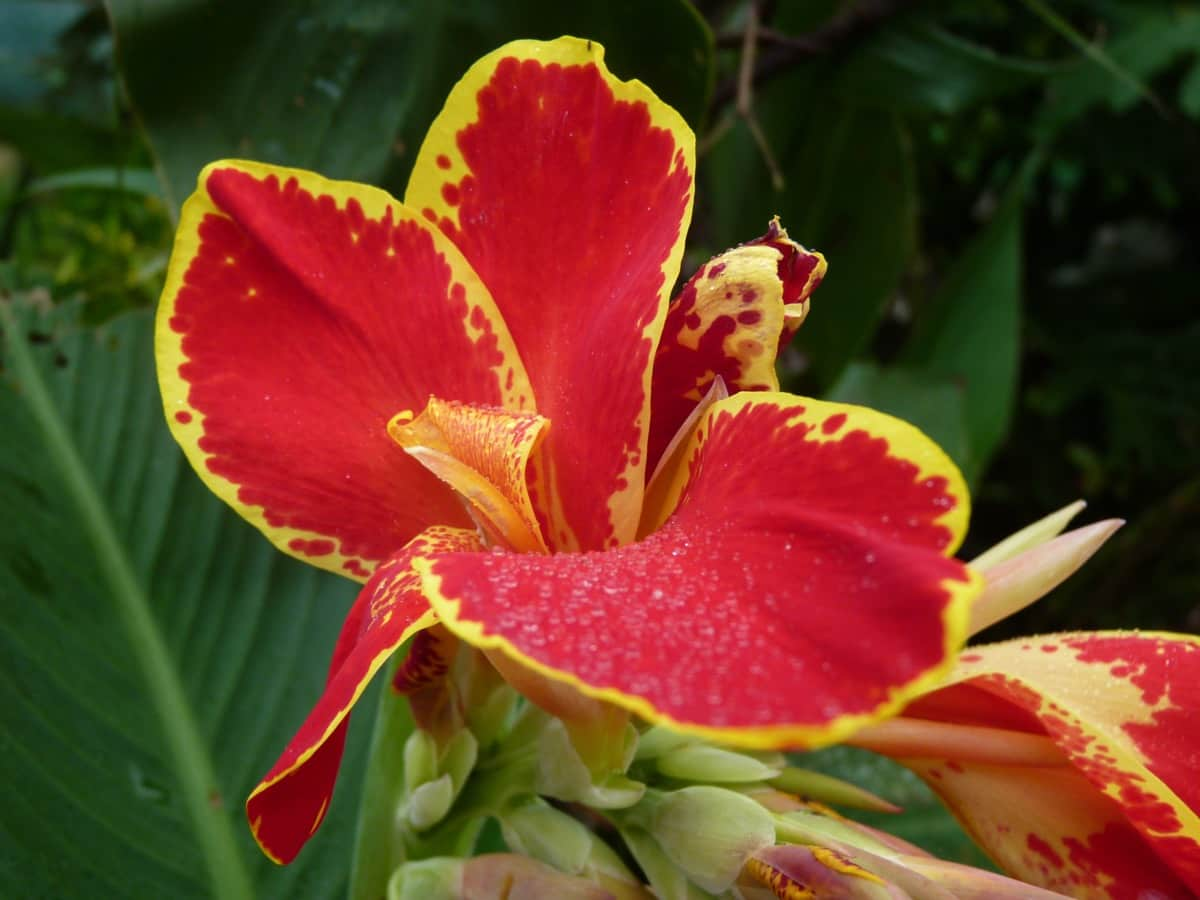Canna lilies are beautiful and vibrant plants that can add a touch of tropical charm to any garden or landscape. However, like other plants, they are not immune to certain problems. This document will explore some common issues that canna lily plants may encounter and provide tips on addressing them.

9 Common Problems With Canna Lily Plants
Yellowing Leaves on Canna Lily Plants and Solutions
Canna lilies prefer well-draining soil; excessive moisture can lead to root rot and yellowing foliage. To combat this problem, ensure your canna lily is planted in well-draining soil and avoid overwatering. Avoid soggy conditions that can cause the yellowing of leaves by allowing the soil to dry between waterings. Leaf spots, bacterial blight, and fungal infections are some of the diseases that can affect canna lilies and lead to leaf discoloration. Proper sanitation practices, such as removing and disposing of infected plant debris, can help prevent the spread of diseases.
Brown Spots on Canna Lily Leaves and How to Treat Them
- Fungal diseases, such as Cercospora leaf spot or Botrytis blight, can cause brown spots on Canna Lily leaves. To treat fungal diseases, remove and destroy any infected leaves or plant debris.
- Nutrient deficiencies can also lead to brown spots on Canna Lily leaves. To address nutrient deficiencies, ensure the soil is well-draining and enriched with organic matter. Regular fertilization with a balanced fertilizer.
- Environmental stress factors, such as excessive sunlight, high temperatures, or inadequate watering, can also cause brown spots. To prevent or treat environmental stress-related brown spots, provide the plant with adequate shade, especially during the hottest part of the day.
Wilting or Drooping Canna Lily Plants and Causes
Underwatering in Canna lilies requires regular and adequate watering to thrive. Insufficient moisture in the soil can result in the plant’s leaves drooping and appearing wilted. To prevent this, water the plants deeply, ensuring the soil is moist but not soggy. Overwatering can also lead to wilting or drooping canna lily plants. Poor drainage or excessive watering can cause the roots to become waterlogged, resulting in root rot.
This can manifest as wilting or drooping leaves. To prevent overwatering, ensure the soil has proper drainage and water the plants only when the top inch of the soil feels dry. Another potential cause of wilting or drooping canna lily plants is heat stress. Canna lilies are generally heat-tolerant plants, but extreme heat can take a toll on them. High temperatures can cause the leaves to wilt and droop. Providing shade or moving the container to a cooler location can help alleviate this issue.
Canna Lily Plants Not Blooming and Troubleshooting Tips
Insufficient Sunlight: Insufficient sunlight is often a leading cause of canna lily plants not blooming. These plants need at least six hours of direct sunlight daily to thrive and produce flowers. If your canna lilies are not receiving adequate sunlight, consider relocating them to a sunnier spot in your garden.
Improper Watering: Canna lilies prefer consistently moist soil but not soggy conditions. Overwatering can lead to root rot and hinder flower production. On the other hand, underwatering can cause stress to the plants, resulting in a lack of blooms. Ensure you water your canna lilies deeply and evenly, allowing the soil to dry slightly between waterings.
Nutrient Deficiencies: It can also contribute to canna lily plants not blooming. These plants require a balanced fertilizer high in phosphorus, as this nutrient promotes flower production. If you notice your canna lilies lacking blooms, consider applying a phosphorus-rich fertilizer according to the manufacturer’s instructions.
Curling or Distorted Leaves on Canna Lily Plants
These plants require regular watering, especially during dry weather or high temperatures. Insufficient moisture can stress the plant, leading to leaf curling or distortion. To remedy this, ensure that the Canna Lily receives adequate water, keeping the soil consistently moist but not soggy.
Common culprits include aphids, spider mites, and thrips can suck the sap from the leaves, which causes them to curl or become disfigured. Regular plant inspection for signs of pests, such as small insects or sticky residue, is crucial. If pests are detected, appropriate insecticidal treatments or organic pest control methods should be employed to eliminate the infestation.
Pest Infestation on Canna Lily Plants and Control Methods
Aphids: Aphids are small and soft-bodied insects that suck sap from Canna lilies’ plant leaves and stems. To control aphid infestations, one can use insecticidal soap or horticultural oil. These products should be applied according to the instructions on the label.
Spider Mites: Regularly inspecting the plants can help detect spider mite infestations early. Control measures include spraying the leaves with a strong jet of water to dislodge the mites or applying miticides if necessary.
In case you missed it: 10 Common Problems With Calathea Plant: Treatment and Solutions

Slugs and Snails: Slugs and snails are common pests that can damage Canna lily foliage and flowers. To control these pests, one can use physical barriers like copper tape around the base of the plants or handpick them during dusk or dawn when they are most active. Additionally, using organic bait such as beer traps can effectively attract and drown them.
Root Rot in Canna Lily Plants and Prevention Techniques
Some common symptoms include yellowing or wilting leaves, stunted growth, and a foul odor emanating from the roots. Infected roots may appear brown or black and may feel mushy or soft to the touch.
- Ensure the soil has adequate drainage by amending heavy clay soils with organic matter and creating raised beds or mounds to improve water flow.
- Water Canna Lily plants deeply but infrequently, allowing the top few inches of soil to dry out between watering sessions.
- When planting, ensure they are placed at the correct depth and spaced adequately to allow for airflow around the plants. This helps prevent the accumulation of moisture around the roots.
Leaf Discoloration or Chlorosis in Canna Lily Plants
Nutrient Deficiencies: When the plant lacks essential nutrients like iron, magnesium, or nitrogen, the leaves may turn yellow or develop pale green spots. To address this issue, it is recommended to apply a balanced fertilizer that contains these nutrients.
An Imbalance In Soil pH: Canna lilies prefer slightly acidic to neutral soil conditions. If the soil pH is too high or too low, the plants may struggle to absorb certain nutrients, leading to chlorosis. Adding organic matter or using soil amendments can help balance the pH and promote nutrient availability.
Poor Soil Conditions: Inadequate drainage can cause the roots to become waterlogged, which leads to root rot and nutrient deficiencies. Ensuring proper soil drainage by amending the soil with organic matter or creating raised beds can help prevent waterlogging and promote healthy root development.
Diseases Affecting Canna Lily Plants and Management Strategies
Canna Rust
Canna rust is a fungal disease that primarily affects the leaves of the Canna lily plant. To manage Canna rust
- Remove and destroy infected leaves and debris to minimize disease spread.
- Follow the manufacturer’s instructions to apply fungicides containing active ingredients such as azoxystrobin or chlorothalonil.
Canna Yellow Mottle Virus
Canna Yellow Mottle Virus is a viral disease that affects Canna lilies, transmitted through infected plant material or aphids.
- Remove and destroy infected plant parts to prevent the spread of the virus.
- Control aphids, which act as vectors, through insecticide application or by introducing beneficial insects like ladybugs or lacewings.
- Plant virus-free Canna lily bulbs or rhizomes from reputable sources.
Canna Bacterial Blight
Bacterial blight is a disease that affects Canna lily plants, commonly spread through contaminated water or infected tools.
- Remove and destroy infected plant parts to prevent bacterial spread.
- Practice good sanitation by disinfecting tools and avoiding overhead watering.
- Apply copper-based bactericides to control bacterial growth.
Canna Leaf Roll Virus (CLRV)
- CLRV is a viral disease that affects Canna lilies, primarily transmitted through aphids.
- Remove and destroy infected plant parts to prevent the spread of the virus.
- Control aphids using insecticides or by introducing natural predators.
- Plant virus-free Canna lily bulbs or rhizomes.
In case you missed it: 9 Reasons Why Your Orchid Flowers Are Falling Off: Treatment and Solutions

Conclusion
By being aware of these common problems and taking appropriate preventive measures, you can ensure your canna lily plants remain healthy and vibrant. Regular inspection, proper watering, adequate spacing, and timely pest control are key to maintaining your canna lilies’ overall health and vitality.
- Feed Your Flock for Less: Top 10 Tips to Save on Chicken Feed
- Ultimate Guide to Ossabaw Island Hog: Breeding, Raising, Diet, and Care
- Hatching Answers: The Top 10 Reasons Your Chickens Aren’t Laying Eggs
- Eggs and Economics: Breaking Down the Cost of Raising Backyard Chickens
- Defend Your Greens: Proven Methods to Keep Iguanas Out of Your Garden
- Ultimate Guide to Cinnamon Queen Chicken: A Comprehensive Guide for Beginners
- Ultimate Guide to California Tan Chicken: Breeding, Raising, Diet, Egg-Production and Care
- Ultimate Guide to Marsh Daisy Chicken: Breeding, Raising, Diet, and Care
- 10 Types of Chicken Farming Businesses You Can Start for Profits